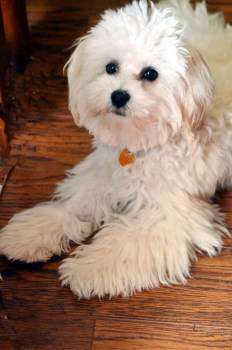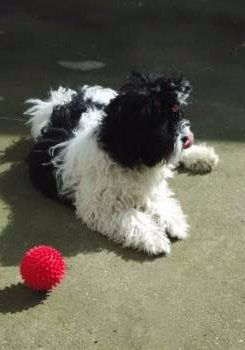Maltipoo Coat and Hair Issues
Overview
One of the most troubling and frustrating issues that an owner can have is when there is an issue with the coat of their Maltipoo. This can include such aspects as:
- The coat thinning out
- The coat seeming to shed (when it should not be)
- Actual areas of complete loss that leads to bare skin showing
- A dry, abnormal texture to the coat of the Maltipoo
- Itching and scratching of the coat (which may be an allergy problem)
Hair issues on a Maltipoo can happen at any time, to a puppy, adolescent or adult dog. Let's take a look at the most common causes of these types of problems.
Please note:
PetMaltipoo is reader-supported. Some of the product suggestions on this page are affiliate links. As an Amazon Associate we earn from qualifying purchases. This is at no extra cost to you and helps us continue creating useful content.
Stress and Coat Loss Issues
When a Maltipoo is under stress, this can actually lead to hair loss problems. Neurodermatitis is a condition in which the Maltipoo dog will compulsively lick their coat to the point of damaging the follicles which then results in patches of bare skins or areas in which the coat is barely there anymore.
This can happen when a Maltipoo puppy or dog is anxious due to Separation Anxiety or changes in environment such as when moving to a new home.
This is diagnosed by ruling out other medical issues and it is treated by resolving triggers of stress or boredom that is afflicting the Maltipoo. While behavior training is an option, changing the home environment often solves this fur loss issue.

Niko
Photo courtesy of Cathy Zakrzewski
First, a Note About Skin
Many Maltipoo's owners worry about the skin color of their Maltipoo and wonder what is normal and what should cause concerns. While every puppy is an individual, most puppies have pink skin. It is normal for this to change as the dog grows from puppy to adult. When an adult dog, the skin color can range from light pink, to dark pink, to tans and even browns. The only time that you should be concerned and bring your Maltipoo to the veterinarian is:
- If the skin has raised areas of darkened skin
- If the skin has sores or lesions
- If the skin looks irritated
If your Maltipoo is going to spend a good amount of time outside in the sunshine with you, you will want to apply some sunblock to your Maltipoo's stomach area. It is just fine to use human sunblock lotion. If your Maltipoo ever has a fur/hair issue, you will want to keep them out of direct sunlight until the problem is resolved.
Maltipoo Puppy Coat
Do Maltipoos have a puppy coat? Do that have a coat change when changing from puppy to adult dog? Learn about possible puppy hair loss.
See also:
Different Maltipoo hair syles
Acantosis Nigricans
This is a medical condition that can be caused by hormonal imbalances, hypersensitivities or friction. It causes the dog's skin to darken, along with a thinning of the coat. If this is to occur, it most commonly happens to a Maltipoo puppy, under the age of 1 year old. Testing will be done by a veterinarian to determine the exact cause. Treatment may include steroids, melatonin injections, and frequent anti-seborrheic shampoos (This is a dog shampoo that must be used careful as they contain salicylic acid, tar, sulfur and propylene glycol which affects the glands of the dog's skin). Vitamin E supplements have been proven to be helpful in many cases.
Allergic Dermatitis
Coat loss is a common symptom when a dog has an allergy
to an external element. Dog shampoo, dog conditioner, even the rug cleaner an owner may use is a possible culprit in causing this reaction to the Maltipoo. Not only will the dog suffer from hair loss, there may be red blisters, sores or lesions on the skin as well. When an external element is causing a negative reaction, the Maltipoo will usually scratch, sometimes severely, at the irritated area. That scratching will then cause the sores, lesions or blisters..and that in turn, will cause hair loss. A Maltipoo may chew at his paws
or lick at them excessively.
Fortunately, this can be quickly corrected once it is determined what is causing the Maltipoo's reaction. A veterinarian should perform patch testing to find the cause and then the owner must eliminate that element. In moderate to severe cases, antihistamines and/or steroids may be prescribed to help a Maltipoo recover.
Alopecia
The cause of this issue is unknown and many dogs can recover from it as mysteriously as they developed it. While many studies have been done, there are no concrete answers. It is thought to perhaps be an autoimmune disorder. This condition will cause random patches of coat loss on the dog. In most cases, unlike an allergic reaction, there will be no itching. This most often fixes itself once the dog's body builds enough antibodies to fend off its inside attacker. In just about every case, the hair will grow back.
Dermatomyositis
This is very odd and disturbing condition in which the hair loss actually occurs alongside a negative reaction to sunlight or UV rays. The cause remains unknown; however there are steps that you can take to help your Maltipoo with this. This condition can be confirmed with a small skin biopsy done by the veterinarian. When a Maltipoo is having a reaction to UV rays, both the coat and the skin will be affected.
The reaction will cause some or all of the following:
- Scabs
- Sores
- Redness
- Irritation (itching, soreness)
Treatment for this will begin by making sure that your Maltipoo has very limited exposure to any sunlight, keeping the dog indoors except for elimination times when they must go to the bathroom. When outside, if possible, you should keep the dog in the shade. Your veterinarian should treat your Maltipoo with Prednisone which may be given in short and small doses initially, and then followed up with vitamin E treatments. The outlook is fairly good for dogs that suffer from this, with the recovery rate being about 85%.
Flea Allergies
The affects of an allergic reaction to a flea bite can be dramatic for dogs that have a high sensitivity. This can present as a rash and often severe hair loss. Treatment will be similar to other allergic reactions, with anti-inflammatory medication, perhaps Prednisone shots, topical solutions for any moderate to severe hot spots and antihistamine. Both dog and house will need to be treated for fleas and a more effective preventative method will need to be chosen.
Hypothyroidism
This condition can develop if the thyroid slows down and produces a smaller amount of hormones than needed. Before hair loss occurs, the coat may become very dry and brittle, which will cause hair to break off easily. If this happens, you will notice this most when you groom
your Maltipoo and in severe cases, just by patting and stroking the coat.
The under active thyroid may also cause your dog to gain weight and make your Maltipoo weak and tired. This can be diagnosed when the veterinarian runs thyroid tests. Treatment will be medication, often needed for the rest of the dog's life to maintain normal levels. Recovery is a progressive process that does take some time, however most Maltipoos will make a complete recovery.



